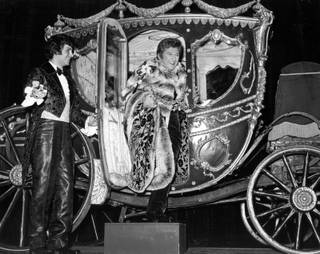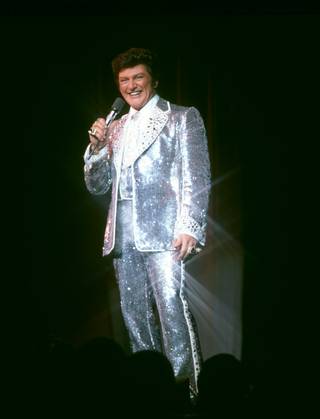Thursday, Sept. 16, 2010 | 2 a.m.
Liberace Museum Tour (April 15, 2009)
John Katsilometes visits the Liberace Musuem for a museum tour on its 30th anniversary.
Liberace
As the highest paid entertainer in 1955 making $50,000 a week at the Riviera, Liberace paved the way for a generation of marquee entertainers who would draw thousands of people to the Strip with just a mere flashing of their names in lights.
Liberace museum
Audio Clip
- Liberace Museum: State of the Union
-
Beyond the Sun
Sun archives
- Liberace Museum aftermath: Nateece, officials, fans wonder if there will be an encore (9-11-2010)
- Liberace Museum closing; final day of operation on longtime East Tropicana location Oct. 17 (9-10-2010)
- In move to Strip, Liberace Museum hopes to revive stagnant visitor numbers (1-14-2010)
- (8-12-2010)
- Director waves bye to Liberace Foundation (4-30-2009)
That the Liberace Museum announced last week it would close was not as surprising as the fact it held on for so long. It may have been a charming — if rundown — attraction commemorating a great showman, but it has been a hotbed of drama, and some say financial mismanagement, since Liberace died in 1987.
The entertainer's will, which named as executor his attorney Joel Strote and assigned him trustee of Liberace's scholarship foundation and museum, was fought over in court. Friends, employees and Liberace's sister charged that Strote coerced the entertainer during his final days into signing the agreement, mismanaged Liberace's money and spent it on himself. Strote won the suit.
But critics' overall accusations of mismanagement and misspending by museum officials have never ceased. Those in charge must now pack up the collection of everything from cars to costumes, tackle a mortgage debt and consider how best to honor the flamboyant pianist.
Some fans and former employees have directed blame for the museum's problems at current board Chairman Jeff Koep, who was invited to join the board by Strote.
Ultimately, Koep says, the museum closed because of financial problems because of the economy, location and waning interest, a problem that will be remedied now that the foundation has signed with an entertainment group to tour the collection.
"Closing the museum gets rid of what costs us the most — costs and property," he says. "The endowment has been keeping the museum open.
"Some people ask, 'Why didn't we get a handle on things?' Maybe the board didn't get a handle on things early enough. Maybe we should have closed it sooner. Why should we continue in bad times to manage that property? That shouldn't be the business we're in."
Koep says the board saw the closure coming for several years during which the foundation and museum lost money. In recent years, net assets declined, at one point by more than $500,000 a year, according to Internal Revenue Service 990 forms from 2005, 2006 and 2007. But its net assets, averaging about $13 million from 1998 to 2006, jumped to $20 million in 2006, before landing at $17.4 million in August 2008. During that time, from 1998-2008, expenses exceeded revenue in all but three years.
That means that in 2008, the foundation and museum were worth $4 million more (on paper) than in previous years. Its 2005 financial report shows a sale of stocks of $10 million, resulting in a $45,000 loss. Koep says that was a result of the foundation and museum switching investment management companies.
The question is whether something could have been done to stop the losses.
Although other organizations — the Las Vegas Philharmonic and Nevada Ballet Theatre — braced for the economy at that time by scaling back, the Liberace Museum and Foundation didn't make any large effort to scale back.
It let go its president, Darin Hollingsworth, in 2009, a mutual decision by the board and Hollingsworth, who was paid $120,000. But in January, the board hired one of its members, Jack Rappaport, as president at $90,000, even though it had a museum director on staff.
That the museum and foundation in recent years had two high-level staff members — a president and a museum director — was a departure from 1998-2002, when it had one high-level employee: Sandra Harris, who was in charge of the foundation, the museum and Liberace Plaza.
Some argued that Hollingsworth's hire posed a conflict of interest. Hollingsworth had been a financial adviser with Merrill Lynch and had been director of development of the UNLV Foundation.
But it is Rappaport's position that is the focus of criticism.
Rappaport, a commercial real estate broker, has been managing the property and is involved in the sale of the museum (officials have been shopping it around, offering the property to one group for $3 million to $4 million).
Koep says there is nothing wrong with Rappaport's role — that the board is an unpaid working board, and Rappaport was invited because of his professional background in commercial real estate and could deal with leases, other rental agreements and utility issues.
Rappaport represented the property as a board member, but was never paid for it, Koep says, adding that he also is not the museum's real estate agent.
"He's representing the foundation as its president in selling the property. Our thinking was that if he could get a good real estate deal, we'll take advantage of it. There is no agreement in place that Jack would get any commission whatsoever."
Although Rappaport is being let go along with the other employees at the museum, Koep said it's possible that he or others could stay on in some capacity. "We'll need a transition team," Koep says.
There is also the changing of the investment company to Hollingsworth's former firm, which he formally introduced to the board. In fiscal year 2005, Koep says, money was transferred from its San Francisco investment company to the local Merrill Lynch — Hollingsworth's former company where a friend of his worked.
Koep says Hollingsworth presented Merrill Lynch representatives to the Liberace board, which then switched to Merrill Lynch because board members thought they might get better results. Hollingsworth had no input, he said.
Those who claim that switching firms was reckless, Koep says, need to go to Merrill Lynch and ask, 'Did they purposely try to lose money for the Liberace Museum?'"
He also says that because of the market, it's possible the previous firm would have lost that money, too.
Critics also complained last year about the sale of an ornate wooden desk, referred to as an 18th century Louis XV-style desk, purchased by Liberace from a museum in Florida. The desk, part of the collection for years, sat in a glass-enclosed nook off the costume room at the museum.
It was sold to a buyer who saw it mentioned in a newspaper article. Hollingsworth and board members wouldn't say how much the museum received or who purchased it. They said the money would be used to care for the museum's other artifacts, including pianos.
Hollingsworth at the time denied that the sale had anything to do with the museum and foundation's financial status.
"It (the desk) was kind of out of place in the collection," he said. "Most people don't think antiques when they think Liberace. It's Liberace cars, costumes and pianos.
"Deaquisitioning happens all the time in museums around the country, particularly for curatorial and preservation needs. From a curatorial standpoint, we were not able to care for that piece in the way that collector can. I did it for the best intent of the artifact. I have no curatorial expertise for antiques."
Koep says that when museum costs rose (maintenance, preservation, etc.), it dipped into the foundation account. Could a director with museum expertise have helped thwart that?
Its original management was Liberace's brother George and then George's wife, Dora. Then, Myron Martin, who had a music management background, became its director. Strote is an attorney. Harris was the only person on staff with a museum studies degree and professional museum training.
Harris says she understands the issues of economy, location and waning interest, but that during her tenure the problems were not such that the institution was routinely taking money from the foundation account for operating expenses: "Our goal then was for the museum to be self-sufficient and break even."
Harris, who is in Berkeley, Calif., says she would like to volunteer to help with the transition and proper preservation of the collection.
"We spent a lot of years building the museum," she says. "There was a very dedicated staff. I would sincerely hope the collection would remain intact and that it would be used in the way Liberace intended, which is for the public to see it."
Koep says the board has just signed on with Exhibits Development Group to tour the costumes and is looking into donating a couple of costumes to the Smithsonian Institution.
Sun librarian Rebecca Clifford-Cruz contributed to this report.




Join the Discussion:
Check this out for a full explanation of our conversion to the LiveFyre commenting system and instructions on how to sign up for an account.
Full comments policy